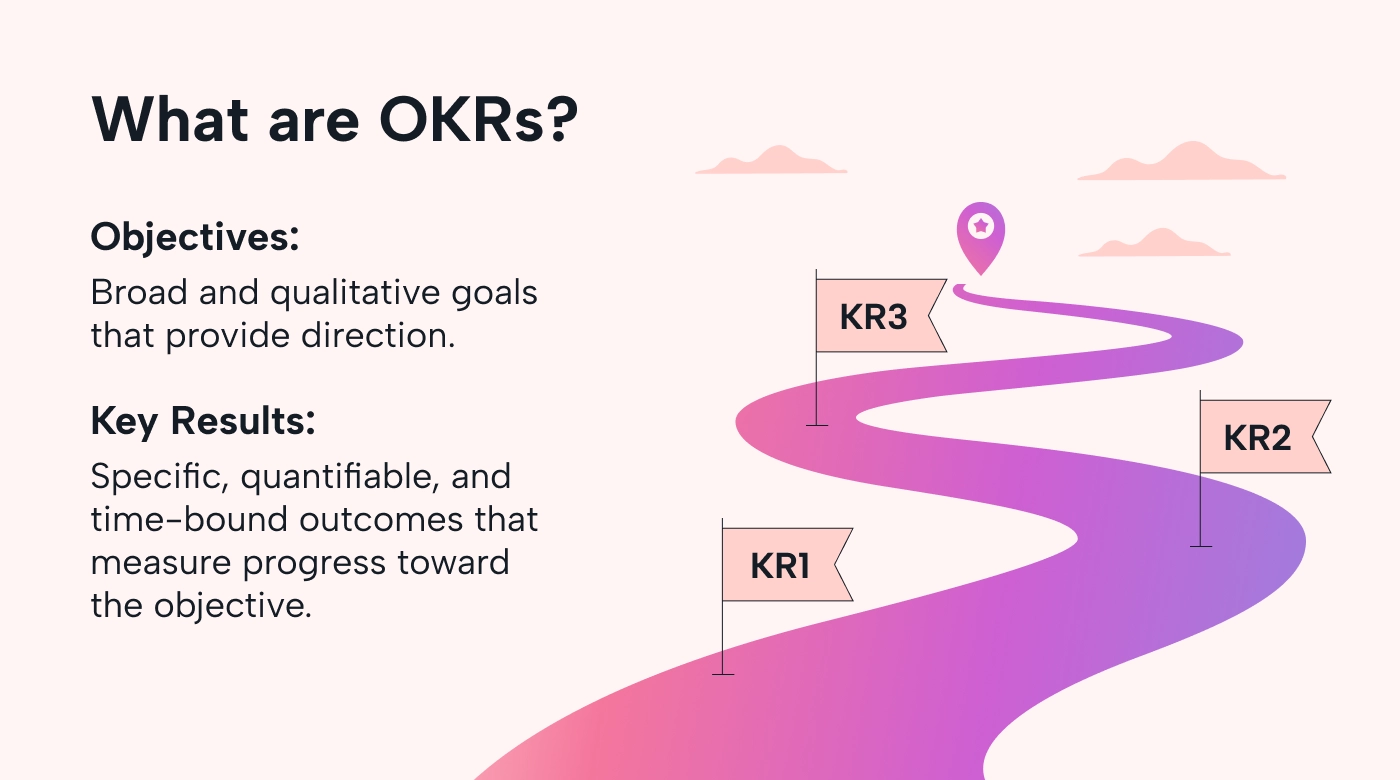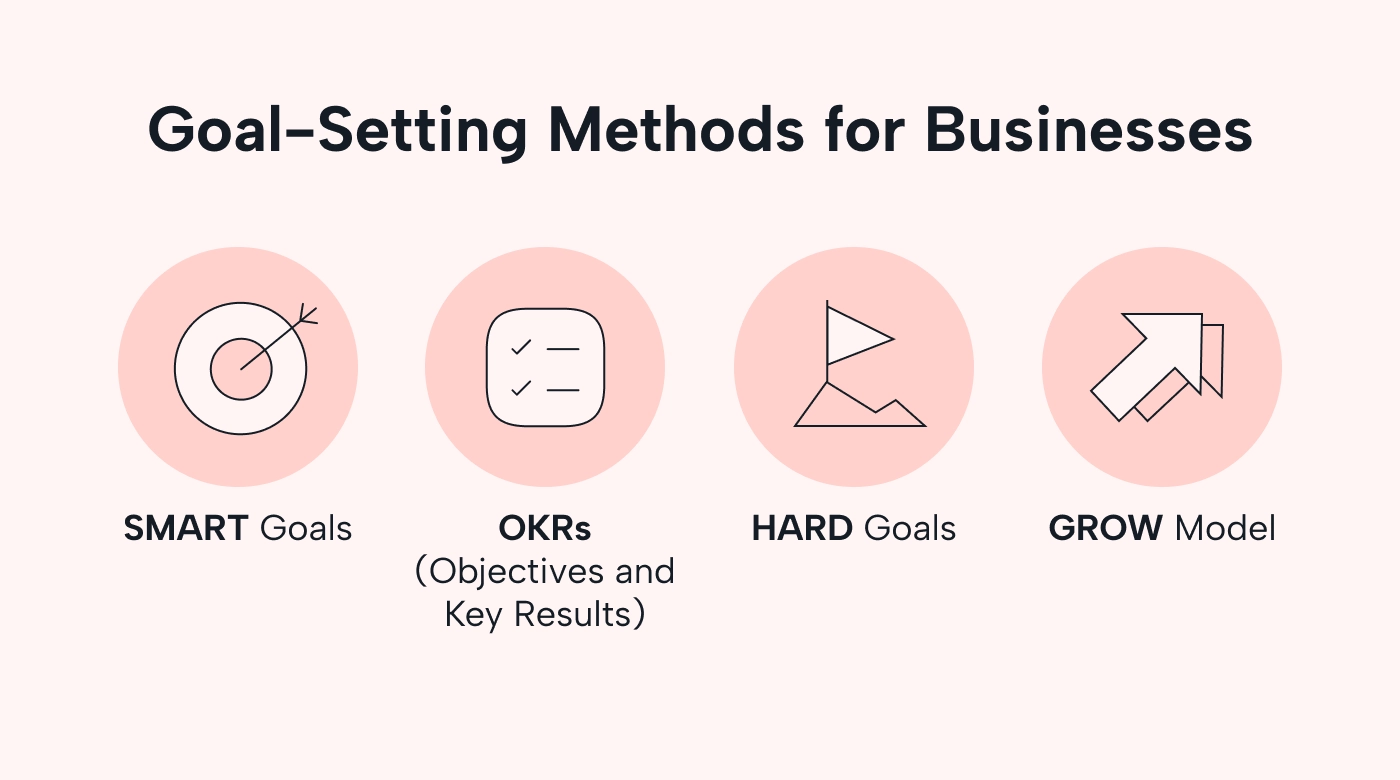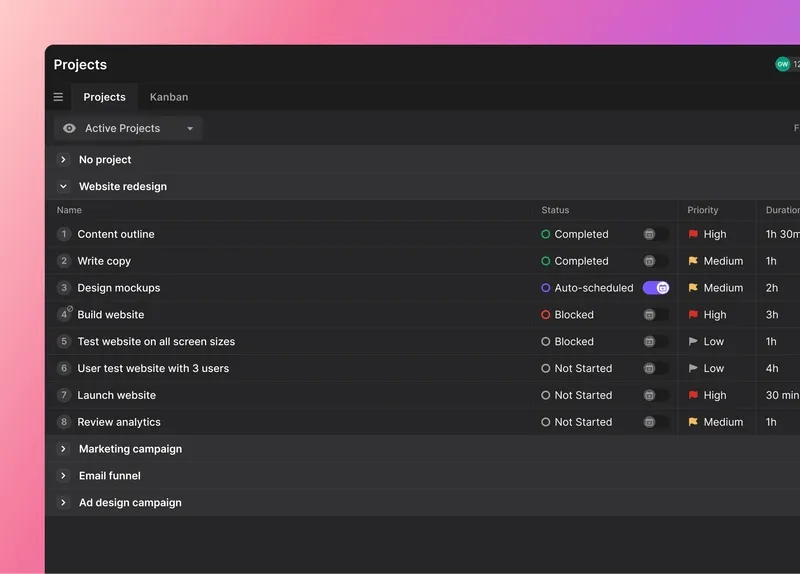As a business owner or project manager, you understand the importance of goal-setting for success.
Without specific objectives, your team members can feel directionless and unsure of where to focus their efforts and resources. This lack of clarity can lead to confusion, missed deadlines, and significant underperformance.
That's why it’s important to set achievable goals with the help of specific methods and worksheets.
In this article, we cover:
- The importance of goal-setting
- Four goal-setting methods and free worksheets
- How to reach your goals
What is goal-setting, and how can it help your business?
Goal-setting forms part of the project management process in business strategy. It involves coming up with clear, specific, measurable goals to guide your team's efforts.
Goal-setting can help your company in the following ways:
Provides teams with direction and focus
Clear goals help teams understand what they need to achieve. This increases productivity and contributes to a high-performance culture in your business.
Prevents stress and burnout
According to the American Institute of Stress, 83% of US employees suffer daily work-related stress.
One of the leading causes of workplace stress is a sudden increase in a worker’s regular workload. So, poor goal-setting (where tasks are given at the last minute, with no warning) can increase the likelihood of burnout among team members.

Allows you to measure performance
Knowing what you want to achieve helps provide clear direction and a process for tracking progress. This means you and your team can measure how well your strategy is performing and make adjustments as necessary along the way.
Allocates resources
Setting goals means knowing which resources — whether human, monetary, or time — are necessary. This can also help you budget better since you'll know what you need to allocate to different tasks.
Improves time management
Goal-setting helps your team members determine their priorities so that they can set time-bound goals for each phase of a project. This is especially true if you use a project management tool like Motion, which automatically sets priorities and assigns tasks to your employees based on their schedules.
4 goal-setting methods and free worksheets
There are many different approaches to setting business goals. Here are four of the most popular goal-setting methods you can use to set goals for your team:
1. SMART goals
Let's start with the most well-known method of setting goals — SMART goals. This framework focuses on helping you set clear and reachable goals. Each component of the acronym helps refine the goal.
The SMART acronym stands for:
- Specific: Define your goal clearly, considering what needs to be accomplished and what key steps must be taken to achieve it.
- Measurable: Create solid criteria to help track progress and measure the outcomes of individual tasks and goals.
- Achievable: Given the available resources and limitations, ensure that your goal is realistic. Consider whether you have the time, money, and human resources necessary to achieve it.
- Relevant: Align the goal with your broader business objectives. Consider whether the goal will help your business move forward in some way.
- Time-bound: Set a deadline or timeframe for achieving the goal. Think of when your team will start and finish so everyone can stay on track.
Setting goals with this approach helps your team focus on one thing at a time. This prevents you from creating too many goals, which can cause confusion and derail your progress.
Depending on the team and campaign, you can be specific about the type of information to include in a SMART goal. For example, imagine you want to introduce a new marketing campaign. Your SMART goal could look like this:
- Specific: Increase the number of email subscribers.
- Measurable: By 25%.
- Achievable: We have a marketing team, an ad budget, and the tools to reach this goal.
- Relevant: This will help us drive direct sales and create higher profits.
- Time-bound: We want to achieve this goal in the next six months.
Goal-setting worksheet template: Hubspot's SMART Goal Worksheet
2. Objectives and key results
Next, we have objectives and key results (OKRs). This goal-setting method connects high-level objectives with measurable outcomes.
- Objectives: What you aim to achieve — broad and qualitative goals that provide direction
- Key results: Specific, quantifiable, and time-bound outcomes that measure progress toward the objective

OKRs give you a clear picture of what you want to achieve and the results you must measure to determine your success. However, unlike the SMART goals method, they don’t consider how to achieve these objectives.
For example, imagine you want to create a better customer experience to increase loyalty and long-term customer value. In this case, your OKRs could look something like this:
- Objective: To improve customer satisfaction.
- Key results:
- Achieve a customer satisfaction score of 90% in the next quarter.
- Reduce the average response time to customer inquiries to two hours.
- Implement a new customer feedback system by the end of the month.
Goal-setting worksheet template: Smartsheet's OKR Goal Worksheet
3. HARD goals
HARD goals are challenging and meaningful. They often focus on your company's mission and emotional and motivational aspects to help drive higher performance and persistence among team members.
HARD stands for the following:
- Heartfelt: These goals are emotionally compelling and inspiring. Think of the deep reason you want to achieve each one.
- Animated: They're vividly described and visualized. Think of what kind of difference you want to make with them.
- Required: They're necessary to achieve the long-term vision of your business. Think of how you’d like your company to look years into the future.
- Difficult: They’re challenging and ambitious. Consider what you'll need to achieve this goal. Money? More skilled employees?
The great thing about HARD goals is that they light up the brain and encourage your employees to perform better.
For example, imagine you have a small construction business and would like to give back to the community by renovating 20 dilapidated homes within two years. In this case, your HARD goal could look like this:
- Heartfelt: Revitalize local neighborhoods by renovating dilapidated homes.
- Animated: Imagine 20 families moving into beautifully renovated homes and the transformation of these run-down properties.
- Required: Improving local housing and supporting community well-being is part of our company’s mission.
- Difficult: Raise $500,000 to complete these renovations.
Goal-setting worksheet template: Happier Therapy's HARD Goal Worksheet
4. GROW Model
The GROW Model is a coaching framework used for goal-setting and problem-solving. It helps individuals and teams clarify their objectives and the best path to achieve them.
Here’s what GROW stands for:
- Goal: Set a clear, specific, measurable goal.
- Reality: Assess your current situation and know where you stand now with your goals, including your challenges.
- Options: Explore strategies and actions you and your team can take to achieve the goal.
- Will or Way Forward: Decide on a detailed action plan you'll follow, including prioritized tasks, when you'll start, and what could get in the way.
Imagine you're a design agency looking to increase the number of client projects. In this case, your GROW goal-setting could look like this:
- Goal: Increase the number of new client projects by 30% in the next six months.
- Reality: We sign 40 new client projects every six months, relying on word-of-mouth and minimal social media presence.
- Options: We can enhance our presence by revamping our website, being more active on social media, or implementing targeted online advertising campaigns.
- Will: We will start by revamping the website and showcasing our portfolio. Then, we will launch a targeted advertising campaign using Google Ads, with a monthly ad budget of $1,500.
Goal-setting worksheet template: Ohio State University's GROW Goal Worksheet

How to reach your goals
Unfortunately, simply setting goals for your team isn't enough. You must also ensure that the required tasks get done and that your team remains focused throughout.
Here are some tips for achieving this:
Inspire your team
Before working toward a goal, it helps to inspire your team and show them what's truly possible. Begin by clearly communicating the company vision and the importance of the goal. Explain how achieving the goal will positively impact your team and the company as a whole.
You can show your employees examples and data to reinforce the importance and impact of the goal so that they’ll have a positive attitude toward it and commit to it wholeheartedly.
Use a project management tool
Efficient project management is crucial if you want to achieve your goals within a specific time frame. A project management system like Motion can help you create the ideal schedules for your team members by automatically adding project work to them.

Motion measures how much your team can accomplish in a certain amount of time and builds a prioritized schedule so they know what tasks to complete first. This streamlines your projects and ensures all team members are always on the same page.
Celebrate milestones
Celebrating milestones is necessary if you want to maintain motivation. You can recognize and reward your team's efforts whenever they reach a significant milestone.
This can be done through:
- Public acknowledgments
- Rewards (such as time off or bonuses)
- Small team celebrations (like treating them to a meal at a fancy restaurant)
This boosts team spirit, reinforces the importance of the goal, and encourages continuous effort.
Stay flexible and focus on the things you can control
No matter how carefully you plan, issues will arise at some point. Make sure you leave room to solve these problems.
Maintain a flexible approach and be prepared to adapt whenever problems arise or circumstances change.
It's also important to avoid focusing on the things that you can’t control, such as economic changes, market fluctuations, and inflation.
FAQ
Let’s take a look at the answers to some common questions about goal-setting.
What are the 5 Rs of goal setting?
The 5 Rs of goal setting designed to help teams set, track, and achieve their goals are as follows:
- Relevant: Goals should be aligned with the company's broader vision.
- Realistic: Goals should be achievable and practical.
- Results-orientated: Goals should be focused on specific targets.
- Resource-based: Goals should consider the human, monetary, and time resources needed to achieve them.
- Rewarding: Goals should offer rewards and a feeling of accomplishment once achieved.
How do you break down goals?
How you break down your goals depends on your chosen goal-setting framework. However, this generally includes the following:
- Defining the main objective
- Identifying the key components
- Creating actionable steps to achieve the goal
- Setting deadlines
- Assigning responsibilities
- Monitoring and adjusting as needed
How do you fill out a SMART goals worksheet?
Filling out a SMART goals worksheet is straightforward; you can simply follow the acronym.
Start by defining a specific and measurable goal.
Then, confirm the goal is achievable (i.e., can it realistically be achieved with your resources?), and make sure it's relevant to your company's bigger vision. Finally, set a deadline so that your team knows exactly what needs to be done and when.
Use Motion to manage your projects
Setting goals for your business can significantly improve your employees' productivity and project results. Using one or more goal-setting methods based on your unique requirements will help you set goals that align with your company's vision.
After you've determined your team's goals, why not use a tool like Motion to automatically assign tasks to your employees based on their schedules and priorities?
Try Motion for free today to see everything it can do for you and your team.

As a journalist and content writer, Carla Bauto Deña crafts stories for both traditional and digital platforms. She loves harnessing the power and accessiility of tech tools to uplift local and global communities.




